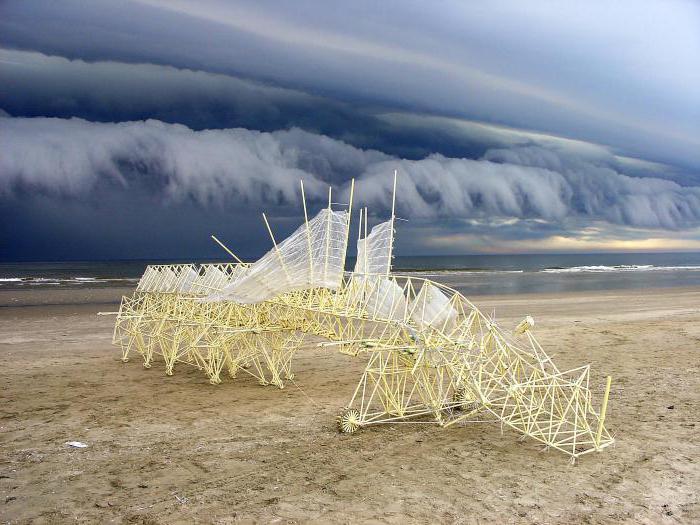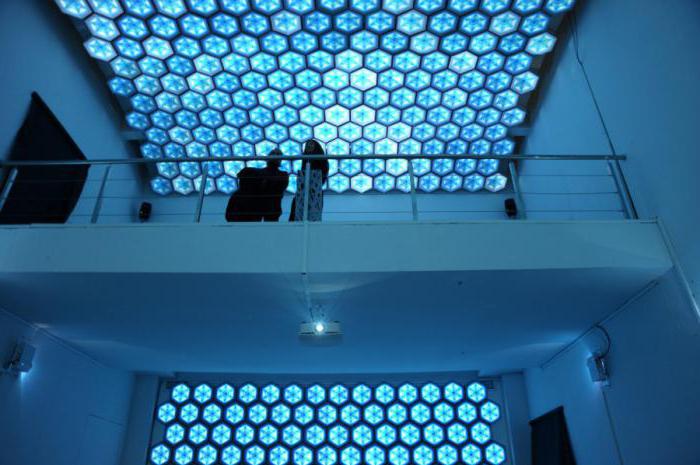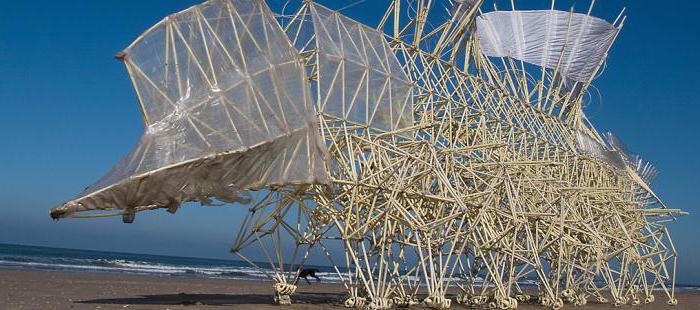The most interesting in art: Theo Jansen and his kinetic sculptures
On the Dutch beaches you can see a new kind of life. Strange creatures move on dozens of legs with the help of a wind that inflates large sails located on their backs.

Engineer Theo Jansen, who created a new life, namedtheir strangers, which in Dutch means "beach animal". These sculptures have no eyes, and they avoid the surf by means of special antennas. The most surprising thing is that these creatures are made up of plastic tubes.
Engineer, creating a new life
The Dutch artist and sculptor Theo Jansen won his fame thanks to kinetic sculptures, featuring special mechanisms that resemble the skeletons of fairy-tale creatures.
The first beach multi-legged monsters Jansen begancreate in the early 90-ies of the last century. A talented sculptor says that he has not been able to stop since that time. Initially, his idea was that the self-propelled creations were to collect the spilled sand into the dunes, thereby acting in favor of Holland. But in the end, the sculptor was delighted with his pets and did not pursue practical goals.

Theo Jansen, whose sculptures fascinate and amaze, traveled the whole world with them. An amazing circus with self-propelled structures everywhere waiting and accept with delight.
Kinetic sculptures from Holland
By designing moving sculptures moreSeventeen years old, Jansen says he creates his works so that they can more naturally fit into the wild. The wind and the sun's rays perfectly emphasize the exclusivity of kinetic animals.
Theo Jansen lives and works on the seaside inthe heart of The Hague. The creator admits that it is the sea breeze that is his main inspiration, because the main thing in kinetic sculptures is a movement that allows you to see the work entirely.
Modern mechanics: how the mysterious mechanisms work
Any subsequent generation of beach sculpturesdiffers from the previous, becoming more modernized. With each time, the designs are increasingly adapted to the conditions of sandy beaches and are more successfully transferred by the influence of water and wind.

To create a framework, Jansen uses cheapPVC pipes. The interior of the sculpture consists of plastic bottles filled with air. Coming into contact with the wind, the figures begin to move. Many of them can move even when there is no wind, accumulating air pressure.
The talented sculptor Theo Jansen invented suchmodels that reliably attach to one place during a storm and even know how to recognize their own immersion in water. This extraordinary evolution is a deliberate step that the author made in order to reproduce real life with the help of art.
The windy art of Theo Jansen in Moscow
Exhibition of a Dutch sculptor called"The kinetic life of sandy beaches" was held in Moscow. She worked for several months at VDNKh in the pavilion "Space". For the time of the exhibition, the famous site turned into a beach, on which amazing and mysterious creatures strolled.

The exhibition was organized by the Polytechnicmuseum, which moved to VDNH due to the reconstruction of an outdated building. And if before that there was a cult in the museum, now it was replaced by new mechanisms with intelligence.
Every time the exhibition of a talented engineercause in the mass public interest and adoration. The real wizard deserves to be called Theo Jansen. Sculptures, controlled by the wind, in an unknown manner hypnotize the spectators standing next to them all day








